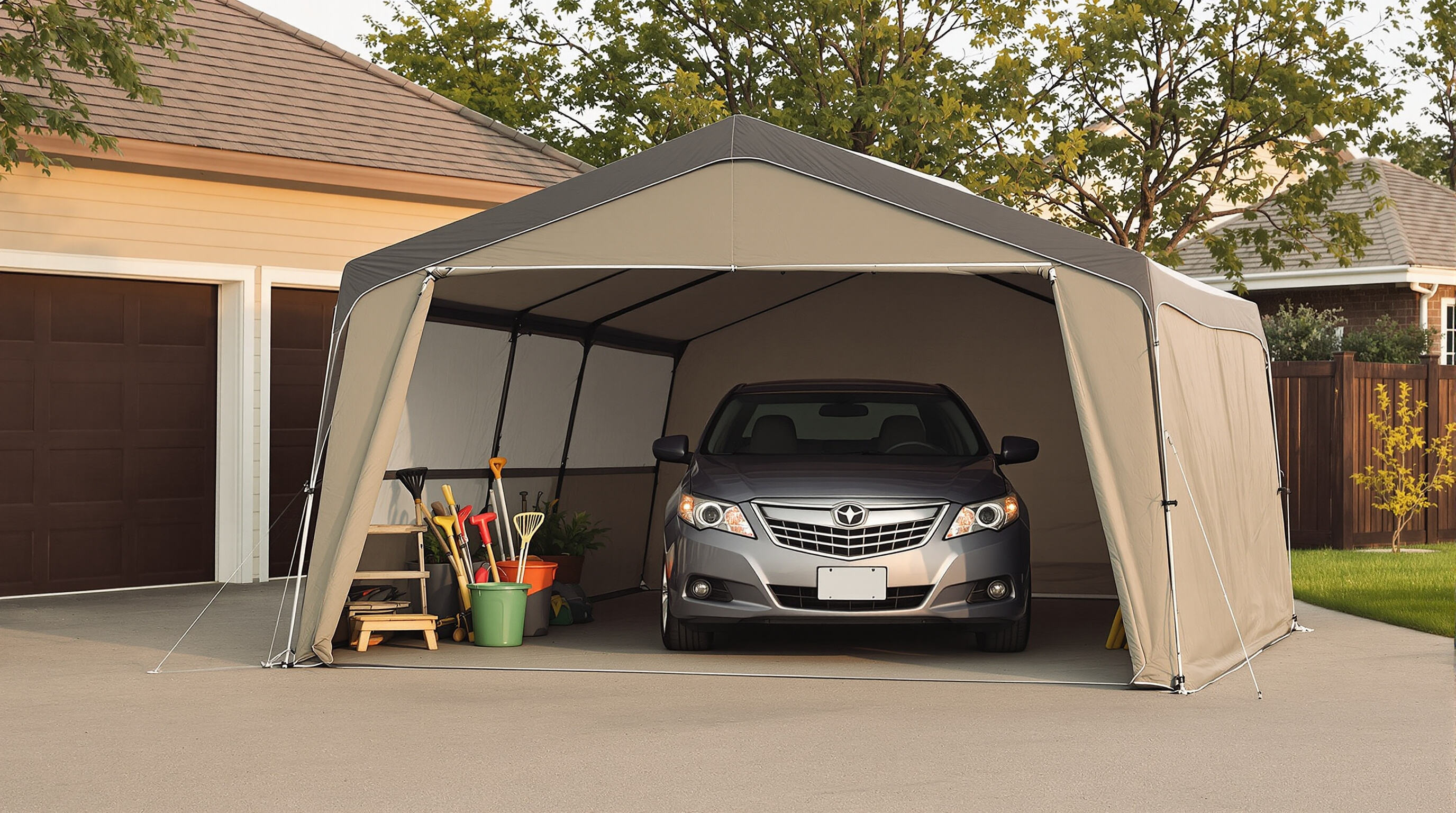Garage Car Tents: Exploring Storage Solutions
What Is a Garage Car Tent and Why It's a Game-Changer for Vehicle Storage
Defining the Garage Car Tent: How It Differs From Traditional Garages and Carports
For folks looking for something between a full blown garage and just parking outside, garage car tents are pretty handy options. Made from tough stuff like polyethylene or those heavy duty polyester fabrics coated with PVC, these tents stand on their own without needing any kind of ground work or permission from local authorities. Traditional garages? They tend to run anywhere from around $28k all the way up to nearly $50k according to HomeAdvisor last year. That's a lot when compared to what these tents cost. Plus there's no dealing with permits or waiting months for construction crews. The fact that they fold up so easily means people who rent apartments, folks traveling across country, or anyone wanting seasonal coverage for their vehicles find them really convenient. Just pack it away when not needed and set it up again wherever required.
The Growing Demand for Portable Car Garages in Urban, Rural, and Off-Grid Settings
City folks often grab garage car tents when dealing with those pesky parking restrictions, whereas folks living out in the country need them mainly for keeping farm gear safe from weather damage. People who love getting off the beaten path really appreciate how these tents can be put together piece by piece to shield their rugged adventure vehicles. According to recent data from the Outdoor Industry Association, around two thirds of people who enjoy spending time outdoors rank fast assembly as super important when shopping for one of these shelters. The latest versions now come equipped with spots for solar panels and stronger anchor points that hold up against heavy snowfall weighing in at 25 pounds per square foot. This means they work well whether someone is setting it up in a mountain pass or along coastal roads where storms roll in unexpectedly.
Core Advantages: Weather Protection, Affordability, and Ease of Setup
- Weather resistance: Multi-layered fabrics block 99% of UV rays and withstand winds up to 50 mph.
- Cost efficiency: Priced between $200–$1,500, they are up to 90% cheaper than built garages.
- Assembly speed: Most units deploy in under 30 minutes using color-coded poles and tension straps.
Modern versions now feature zippered ventilation panels and anti-condensation layers, key upgrades that resolve moisture issues common in earlier portable designs.
Weatherproof Design and Material Innovation in Garage Car Tents
How Waterproof Car Storage Tents Resist Rain, Snow, and Moisture Penetration
Modern garage car covers now come with some pretty impressive water protection tech. Most high quality models use triple layer polyethylene fabric rated at around 15,000mm against water pressure, which is what most manufacturers consider top tier performance. The stitching areas are completely sealed too, so water doesn't sneak through those tiny holes. Manufacturers also design them with smart airflow systems including ridge vents and mesh panels along the sides to cut down on dampness inside. According to research done last year looking at about 200 owners, nearly nine out of ten reported their cars stayed dry even during major rain events when they had all these features properly installed.
UV Resistance, Wind Stability, and Seasonal Durability: What to Look For
To ensure long-term performance, choose materials engineered for multiple environmental threats:
- UV Protection: UPF 50+ fabrics block 98% of harmful rays, reducing material degradation
- Wind Resistance: Models rated for 55–65 mph winds typically feature trussed frames and ratchet-strap anchoring
- Snow Load Capacity: Look for 20–35 lbs/sq ft ratings to handle regional snowfall averages
Field data shows that tents made with 190D polyester-polyethylene blends last three times longer in desert climates than in coastal areas due to salt-air corrosion.
Advancements in Reinforced Fabrics, Seam Sealing, and Climate-Resilient Materials
Recent innovations have significantly improved structural integrity and climate adaptability:
- Nano-ceramic coatings repel water, dirt, and tree sap while enabling self-cleaning surfaces
- 3D-knit panels reduce seam count by 40%, enhancing strength and minimizing failure points
- Phase-change materials embedded in walls help regulate internal temperatures within ±15°F
Manufacturers now use radar-welded seams instead of stitched joints, eliminating a major weak point under prolonged stress.
Portable Car Shelters as Flexible Alternatives to Permanent Garages

Why Modern Lifestyles Favor Garage Car Tents Over Fixed Structures
Mobility is now a big deal for most suburban families according to a recent 2023 survey where about 6 out of 10 households listed it as their main concern. That's why many people are turning to garage car tents instead of building permanent structures. These tents sidestep those costly permits which typically run anywhere from around $1,200 up to nearly $4,500. Plus they give quick cover for cars, gardening gear, holiday decorations whatever needs protection outside. For folks who rent homes or love hitting the road for adventures, these portable solutions make sense since they can pack everything up within just under ninety minutes when needed elsewhere. The convenience factor is huge while still keeping valuables safe from weather damage.
Comparing Portable Tents With Large Vestibules vs. Traditional Garages
| Feature | Garage Car Tents | Traditional Garages |
|---|---|---|
| Weather Resistance | Withstands 45+ mph winds (2024 ASTM tests) | Fixed protection, no mobility |
| Setup Time | 2–4 hours with basic tools | 6–12+ weeks for construction |
| Cost | $300–$2,500 initial investment | $25,000+ average build cost |
| Storage Capacity | 120–400 sq ft with expandable vestibules | Fixed dimensions |
Maximizing Space: Integration With Car Camping and Outdoor Living
Advanced models feature dual-layer walls and adjustable partitions, allowing customization into zones for gear maintenance, battery charging, or camping storage. This adaptability is especially valuable for overlanders who need space for rooftop tents, recovery boards, and portable kitchens—all protected alongside their vehicles.
Modular Designs That Connect to Camping Shelters
New coupling systems let garage car tents attach directly to pop-up living quarters, forming integrated shelter complexes. Shared anchor points maintain wind stability, a critical advantage demonstrated in 2023 field tests where connected units survived 18" snow loads in mountainous regions.
Practical Applications: From Daily Use to Adventure-Oriented Vehicle Protection
Garage car tents serve both everyday needs and specialized scenarios, evolving beyond simple vehicle covers into versatile storage solutions for modern lifestyles.
Using Garage Car Tents as Multifunctional Hubs for Tools, Gear, and Trip Prep
These units serve as secure prep areas when heading outdoors too, since folks can stash bikes inside along with kayaks, trailers, and all sorts of off road equipment. Contractors often park these near their work trucks so tools stay handy during jobs. Meanwhile regular families tend to rotate holiday decorations and garden stuff through the seasons. According to a survey from last year, around two thirds of users actually put their tents to work this way, adjusting what goes inside depending on what time of year it is. Makes sense really, given how versatile these spaces turn out to be.
Balancing Aesthetics and Utility in Residential Neighborhoods
Contemporary designs prioritize visual integration with residential architecture. Neutral-toned, UV-resistant gray or beige fabrics and low-profile frames meet HOA standards better than industrial metal carports. Tapered legs and retractable sidewalls preserve airflow and curb appeal, easing concerns about temporary structures detracting from neighborhood aesthetics.
Ideal Use Cases: Seasonal Storage, RV Support, and Mobile Work Vehicles
- Seasonal storage: Premium models support up to 40 PSF snow loads, ideal for protecting classic cars or boats from harsh weather.
- RV support: Provide dedicated space for generators, grills, and camping gear adjacent to motorhomes.
- Mobile work vehicles: Food truck operators and tradespeople use them as pop-up workshops, combining weather protection with functional workspace.
This versatility has driven strong market adoption—garage car tents now outsell traditional metal carports 3:1 in areas with space constraints or high transient populations, according to 2024 retail analytics.
Security, Durability, and Long-Term Value of Garage Car Tents
Evaluating Theft Resistance: Anchoring Systems and Locking Mechanisms
The security game has definitely gotten better thanks to stronger anchoring systems and those pesky tamper-proof designs nobody wants to deal with. The top of the line units come with serious ground stakes or super heavy bases that can stand up against wind gusts over 65 mph according to that recent Shelter Structures report from last year. Most zippered entry points now have loops where people can attach padlocks, while some models go even further by adding steel cables along the seams so would-be thieves can't just cut through them. Cities are starting to see smart combinations where these shelters get paired with motion lights, creating protection levels that actually rival what we've traditionally seen in regular garages across town.
How Long Do Waterproof Car Storage Tents Last? Lifespan Under Regular Use
The best quality models typically run for around 3 to 5 years when looked after properly. They're built using UV stabilized polyethylene fabric at least 180 grams per square meter thick, along with steel frames that have been coated with powder paint for extra protection. Where they sit matters too though. Canopies near the coast tend to show signs of wear about 20 percent quicker because salt in the air eats away at the materials. Good news is there are ways around full replacements these days. Systems like Garage in a Box let people just replace specific parts that get damaged instead of chucking out whole structures. Manufacturers have made some pretty decent improvements since 2020 actually. Most products now last roughly 40% longer than before, and some premium ones can stick around for well over seven years if placed somewhere with mild weather conditions.

